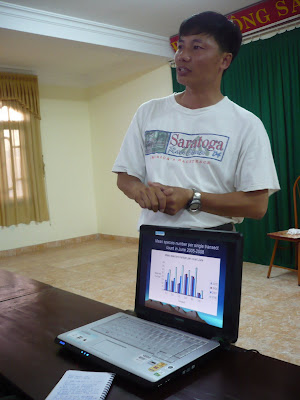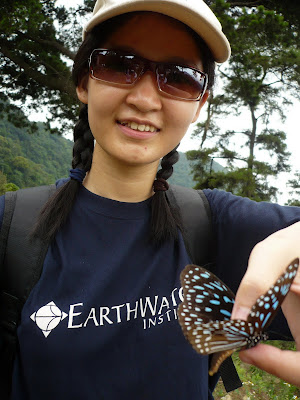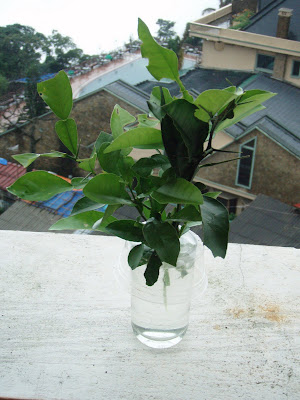
I'm lucky enough to be one of 24 employees worldwide being awarded a British American Tobacco Earthwatch Employee Fellowship in 2008. I participated as a field assistant in the Butterflies of Vietnam Earthwatch Expedition and together with me during the escapade was Nafisa Usmanova from BAT Uzbekistan . Butterflies of Vietnam is an international scientific field research expedition to study butterflies in the protected Tam Dao National Park , leads by Dr. Vu Van Lien.

I received a lot of blessings, as well as interesting questions from GSD colleagues before I left for the expedition. Most common questions were: why butterflies? Are you going to catch them? What you do with the butterflies? Therefore, I think it’s necessary to share with everyone the research aims :
To detect temporal changes in butterfly populations
Using the results to inform butterfly conservation management practices
Continue effort in monitoring local butterflies over the long-term to reveal stabilization
Conservation of butterflies as well as forests and other ecosystems viability of Tam Dao’s luxuriant hillside forest.

Dr. Vu is a local ecologist who serves as the Principle Investigate for Butterflies of Vietnam since 2002. He is assisted by Mr. Anh and Mr. Viet, both local researchers. Besides Nafisa and I from BAT, four Singaporean volunteers sponsored by HSBC and four independent volunteers from United States were in the team. A German photographer was with us throughout the expedition. We were from different walks of life yet being linked for the same mission: biodiversity and environment.

The expedition started with classroom training and briefing by Dr. Vu.


We did some butterfly specimens as well.



Let me start with Vietnam, followed by Tam Dao and lastly the butterflies transects. Socialist Republic of Vietnam is the easternmost country on the Indochina Peninsula in Southeast Asia, with a population of over 86 million. Tam Dao is a protected area zone in North Vietnam. The park is about 85 km northwest of Hanoi (capitol of Vietnam) and has more than 20 peaks with an altitude of over 1000m.

Transect is a path along which we record and count occurrences of the phenomenon of butterflies. This is a way of sampling populations and measuring the changes between at least two areas. We walked and hiked over a distance of 3 - 12 kilometres on transects for approximately 3 - 8 hours daily, carrying 3 – 5 kilograms load. Our butterfly transects include:
1,200 uneven steps covered in moss and mud
950 meters up to 1,450 meters through forest and over slippery stones. The ground is mostly wet due to plant cover blocking the sun
700 meters along a narrow and uneven path in the forest.
2 km/1.2 mi around the Tam Dao tourist area on the forest edge.
2 km/1.2 mi of new road currently being constructed with small rocks in some places.


Field Activities
The first field activity was to identify butterflies by sight e.g. distinguishing between butterflies and moths, identifying families and common species . The presence/absence and abundance of butt erfly specie s, esp ecially fo r e st indicator an d rare species, were recorded on different butterfly transects.

Butterflies were collected using butterfly net. Ideally, the butterfl y should be caught in a sweeping motion that drives it into the end of the net, so that the net can be twisted over to prevent it from escaping. If th e butterfly settles on the ground, drop the framework over it and hold the net up. When the butterfly flies upwards, sweep the net below to imprison it (see the picture).



Once we caught the butterfly in the net, next step is to take the butterfly out without harming it. In order to do this I’m extremely careful not to grab the wings. In fact, Dr. Vu demonstrated how to gently trap the head in between two fingers (one finger on top, one on the bottom) and hold on softly.

We observed and recorded butterflies informatio n (species and count) into datasheets. Vegetation and forest types of all transect have been documented as well as any changes and disturbances of vegetation along transects.

During the field work, we were looking for eggs, caterpillars, pupas and food p lants for butterfly caterpillars.

Eggs and caterpillars were collected and raised to adults in transparent plastic boxes and breeding cages with dimensions of 30cm to 50cm.

Caterpillars are supplied with fresh food plants daily. Breeding boxes and cages are cleaned regularly. Information on the life cycles of butterflies and biota such as temperature and humidity were recorded. We observed the ecology and behavior of butterflies and each species.


My late wife Linda and I went on this expedition in September, 2002. What a wonderful exoerience! I want to go again.
ReplyDelete